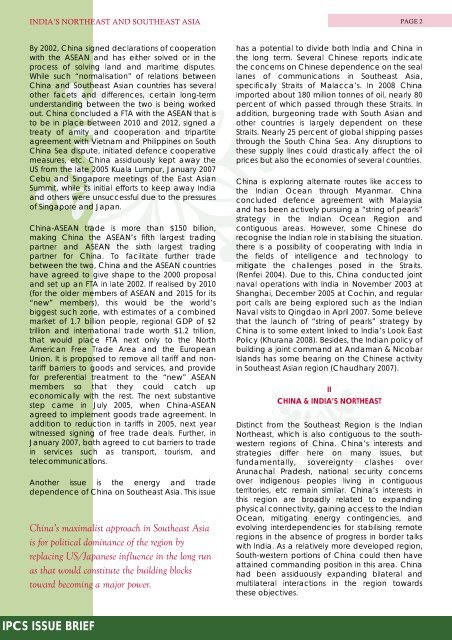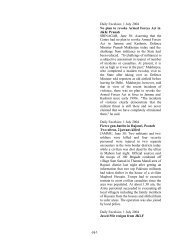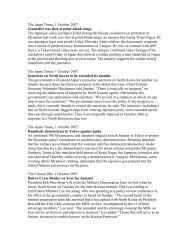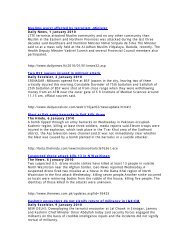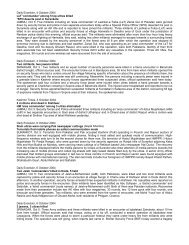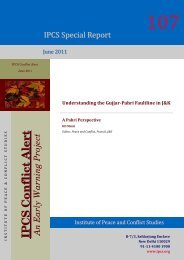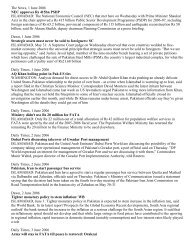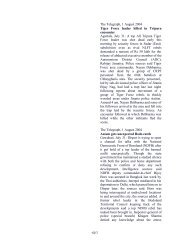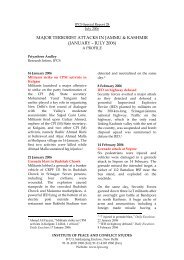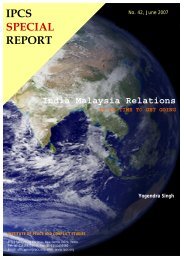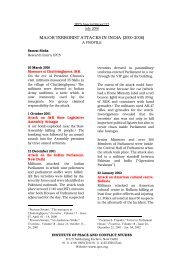India's Northeast and Southeast Asia - Institute of Peace and Conflict ...
India's Northeast and Southeast Asia - Institute of Peace and Conflict ...
India's Northeast and Southeast Asia - Institute of Peace and Conflict ...
You also want an ePaper? Increase the reach of your titles
YUMPU automatically turns print PDFs into web optimized ePapers that Google loves.
INDIA’S NORTHEAST AND SOUTHEAST ASIA<br />
PAGE 2<br />
By 2002, China signed declarations <strong>of</strong> cooperation<br />
with the ASEAN <strong>and</strong> has either solved or in the<br />
process <strong>of</strong> solving l<strong>and</strong> <strong>and</strong> maritime disputes.<br />
While such “normalisation” <strong>of</strong> relations between<br />
China <strong>and</strong> <strong>Southeast</strong> <strong>Asia</strong>n countries has several<br />
other facets <strong>and</strong> differences, certain long-term<br />
underst<strong>and</strong>ing between the two is being worked<br />
out. China concluded a FTA with the ASEAN that is<br />
to be in place between 2010 <strong>and</strong> 2012, signed a<br />
treaty <strong>of</strong> amity <strong>and</strong> cooperation <strong>and</strong> tripartite<br />
agreement with Vietnam <strong>and</strong> Philippines on South<br />
China Sea dispute, initiated defence cooperative<br />
measures, etc. China assiduously kept away the<br />
US from the late 2005 Kuala Lumpur, January 2007<br />
Cebu <strong>and</strong> Singapore meetings <strong>of</strong> the East <strong>Asia</strong>n<br />
Summit, while its initial efforts to keep away India<br />
<strong>and</strong> others were unsuccessful due to the pressures<br />
<strong>of</strong> Singapore <strong>and</strong> Japan.<br />
China-ASEAN trade is more than $150 billion,<br />
making China the ASEAN’s fifth largest trading<br />
partner <strong>and</strong> ASEAN the sixth largest trading<br />
partner for China. To facilitate further trade<br />
between the two, China <strong>and</strong> the ASEAN countries<br />
have agreed to give shape to the 2000 proposal<br />
<strong>and</strong> set up an FTA in late 2002. If realised by 2010<br />
(for the older members <strong>of</strong> ASEAN <strong>and</strong> 2015 for its<br />
“new” members), this would be the world’s<br />
biggest such zone, with estimates <strong>of</strong> a combined<br />
market <strong>of</strong> 1.7 billion people, regional GDP <strong>of</strong> $2<br />
trillion <strong>and</strong> international trade worth $1.2 trillion,<br />
that would place FTA next only to the North<br />
American Free Trade Area <strong>and</strong> the European<br />
Union. It is proposed to remove all tariff <strong>and</strong> nontariff<br />
barriers to goods <strong>and</strong> services, <strong>and</strong> provide<br />
for preferential treatment to the “new” ASEAN<br />
members so that they could catch up<br />
economically with the rest. The next substantive<br />
step came in July 2005, when China-ASEAN<br />
agreed to implement goods trade agreement. In<br />
addition to reduction in tariffs in 2005, next year<br />
witnessed signing <strong>of</strong> free trade deals. Further, in<br />
January 2007, both agreed to cut barriers to trade<br />
in services such as transport, tourism, <strong>and</strong><br />
telecommunications.<br />
Another issue is the energy <strong>and</strong> trade<br />
dependence <strong>of</strong> China on <strong>Southeast</strong> <strong>Asia</strong>. This issue<br />
China’s maximalist approach in <strong>Southeast</strong> <strong>Asia</strong><br />
is for political dominance <strong>of</strong> the region by<br />
replacing US/Japanese influence in the long run<br />
as that would constitute the building blocks<br />
toward becoming a major power.<br />
has a potential to divide both India <strong>and</strong> China in<br />
the long term. Several Chinese reports indicate<br />
the concerns on Chinese dependence on the seal<br />
lanes <strong>of</strong> communications in <strong>Southeast</strong> <strong>Asia</strong>,<br />
specifically Straits <strong>of</strong> Malacca’s. In 2008 China<br />
imported about 180 million tonnes <strong>of</strong> oil, nearly 80<br />
percent <strong>of</strong> which passed through these Straits. In<br />
addition, burgeoning trade with South <strong>Asia</strong>n <strong>and</strong><br />
other countries is largely dependent on these<br />
Straits. Nearly 25 percent <strong>of</strong> global shipping passes<br />
through the South China Sea. Any disruptions to<br />
these supply lines could drastically affect the oil<br />
prices but also the economies <strong>of</strong> several countries.<br />
China is exploring alternate routes like access to<br />
the Indian Ocean through Myanmar. China<br />
concluded defence agreement with Malaysia<br />
<strong>and</strong> has been actively pursuing a “string <strong>of</strong> pearls”<br />
strategy in the Indian Ocean Region <strong>and</strong><br />
contiguous areas. However, some Chinese do<br />
recognise the Indian role in stabilising the situation.<br />
there is a possibility <strong>of</strong> cooperating with India in<br />
the fields <strong>of</strong> intelligence <strong>and</strong> technology to<br />
mitigate the challenges posed in the Straits.<br />
(Renfei 2004). Due to this, China conducted joint<br />
naval operations with India in November 2003 at<br />
Shanghai, December 2005 at Cochin, <strong>and</strong> regular<br />
port calls are being explored such as the Indian<br />
Naval visits to Qingdao in April 2007. Some believe<br />
that the launch <strong>of</strong> “string <strong>of</strong> pearls” strategy by<br />
China is to some extent linked to India’s Look East<br />
Policy (Khurana 2008). Besides, the Indian policy <strong>of</strong><br />
building a joint comm<strong>and</strong> at Andaman & Nicobar<br />
Isl<strong>and</strong>s has some bearing on the Chinese activity<br />
in <strong>Southeast</strong> <strong>Asia</strong>n region (Chaudhary 2007).<br />
II<br />
CHINA & INDIA’S NORTHEAST<br />
Distinct from the <strong>Southeast</strong> Region is the Indian<br />
<strong>Northeast</strong>, which is also contiguous to the southwestern<br />
regions <strong>of</strong> China. China’s interests <strong>and</strong><br />
strategies differ here on many issues, but<br />
fundamentally, sovereignty clashes over<br />
Arunachal Pradesh, national security concerns<br />
over indigenous peoples living in contiguous<br />
territories, etc remain similar. China’s interests in<br />
this region are broadly related to exp<strong>and</strong>ing<br />
physical connectivity, gaining access to the Indian<br />
Ocean, mitigating energy contingencies, <strong>and</strong><br />
evolving interdependencies for stabilising remote<br />
regions in the absence <strong>of</strong> progress in border talks<br />
with India. As a relatively more developed region,<br />
South-western portions <strong>of</strong> China could then have<br />
attained comm<strong>and</strong>ing position in this area. China<br />
had been assiduously exp<strong>and</strong>ing bilateral <strong>and</strong><br />
multilateral interactions in the region towards<br />
these objectives.<br />
IPCS ISSUE BRIEF


